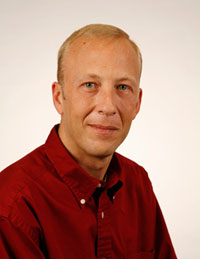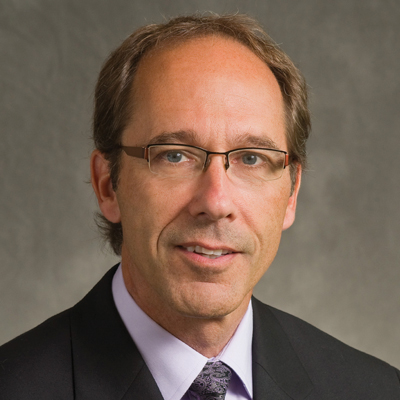
Ben Winchester
Ben Winchester, a research fellow for the Center for Community Vitality at the University of Minnesota Extension, has attracted attention in rural policy circles for describing a phenomenon reflected by his own family. Winchester and his wife are college-educated professionals who watched their friends move to metro areas, while they moved to Hancock, a small town in western Minnesota. While much attention in rural demography focuses on "brain drain"— the exodus of young people—Winchester is both participant in and researcher of a "brain gain" trend seen among 30- to 45-year-olds who are moving to rural America.
fedgazette: Conventional wisdom says that young people are leaving rural towns, old people are staying and rural areas are generally stagnating. What does your research find?
Winchester: People are actually moving to rural places, and it isn't necessarily to work on a farm. This rural renaissance has been happening since the 1970s. And it's not just immigrant communities moving in; it is people moving to just about every rural Minnesota county. These newcomers are largely people between the ages of 30 and 45, some of whom previously lived in a small town and want to return to that lifestyle, while others are looking for an increased quality of life.
These newcomers are a huge benefit. Say a county loses 100 young people between the ages of 18 and 25 after they graduate, but increases its cohort of 30- to 45-year-olds by 60 people. Overall, there is a net loss of 40, but newcomers have mitigated the impact significantly.
Generally, rural research examines total population change to indicate "success" for a community over a 10-year period. These figures are put up on the highway sign outside of town. My focus has been on teasing out the dynamics within the total population change.
fedgazette: So when we hear this story about the brain drain phenomenon, what should we make of it?
Winchester: First off, it's most definitely real. I'm narrowly defining brain drain here as the loss of the high school kids, because this is the way that American rural researchers define the term. Sure, young adults add a lot to a town, but they're certainly not the most educated residents. In fact, by definition, they only have a high school education. They're also not the most skilled and definitely aren't the most experienced. So why are we describing the loss of high school kids as a brain drain?
Meanwhile, when 30- to 45-year-olds move to town, they are in their prime earning years, bringing high skill sets—master's degrees, college degrees. They have a career path and outside connections in various industries. These people are definitely a brain gain.
fedgazette: What about metropolitan areas?
Winchester: We found that core metropolitan counties in Minnesota have great difficulty retaining these same 30-45 age cohorts. Sure, they gain many of the youth, but after the age of 30, people choose to move away from these areas.
fedgazette: Does this phenomenon hold in Great Plains states, where there is a definite hollowing out in terms of rural population?
Winchester: You bet. North Dakota, South Dakota, Iowa, Nebraska, Kansas— you name the state—it's present. Just think about it: If nobody had ever moved back, our communities could have died out 50 years ago. This has been happening for a long time. What is new today is that even higher numbers are moving back.
fedgazette: Who are these people? What is motivating them?
Winchester: Generally, people fall into two categories. One is the returners. These are people who grew up in rural areas and want to get back to that lifestyle. Returners make up about 35 percent to 45 percent of the newcomers. Most of the rest have had very little contact with the rural area where they choose to live. They may have visited that area as a youth or read an article about it or seen something online. It's very idiosyncratic.
fedgazette: Are these job-related decisions?
Winchester: You would think so, but often that's not the case. This is probably the most interesting finding in the research. These are not solely job-related decisions people are making.
fedgazette: So these are lifestyle decisions.
Winchester: These are lifestyle, quality-of-life decisions people are making. The top three reasons people note when they make the move are slower pace of life, safety and security (especially for those who have kids), and the low cost of housing.
fedgazette: But people generally need to work. What kinds of jobs are these people getting? Many have college degrees, so what are they doing?
Winchester: All sorts of things. We haven't done an overall study of all of the newcomers; that's a focus of more research. We've picked out a sample, and we've had interviews with them, and some of these people did not have jobs before they got out here. They sold their house and had enough revenue from their house to purchase a house in a rural community. Especially in the smaller communities, you can almost pay cash for your house up front.
We are finding a significantly high number of self-employed and business owners among newcomers. One in four owned a small business. That is a higher rate of business ownership than among other residents. It makes me wonder what the state of our rural economy would be if these newcomers had not been coming back these past 30 years. If we had not been able to transition our business ownership over to new owners, what would our Main Streets look like?
There was one couple, for example—the husband had come back to farm, and they decided they wanted to find a business for his wife to run, so they looked around town. The flower shop was for sale, so they bought it. We asked, "What if the flower shop wasn't available? What if it was a hardware store?" They responded, "Oh, we would have bought that, then." It didn't matter.
Another thing is that these newcomers who own businesses are heavily invested in their communities, more so than people who just come in and take maybe a temporary or part-time job to see how it works. By the way, we know that a large number of business owners in small towns are over the age of 50.
fedgazette: So succession planning is important for these communities.
Winchester: Exactly, and this provides a real opportunity if we market things correctly. But, and this is a delicate issue, business owners are very hesitant to say their businesses are up for sale because sometimes customers turn away, and it can be tough for community morale. So succession planning is a tough economic development problem for rural communities.

"In southwestern Minnesota, we do see an influx of 30- to 45-year-olds, but they have been unable to keep those people past the age of 45." - Winchester
fedgazette: Has there been an attempt to create some sort of clearinghouse, or is there a way to aggregate this sort of information, so the people who are in the Twin Cities or on the East Coast or in California can check out opportunities? Or is this process more just luck and whimsy?
Winchester: It is whimsy at this point.
fedgazette: It sounds like you need a brokerage service of sorts.
Winchester: Yes. There's definitely a need for that kind of connector. This migration, again, has been happening without those of us in the rural development field doing anything. So imagine where we would be if we actually did just a little bit of something. And we want to have it be a wise use of our public tax dollars too. Economic development agencies, generally, are publicly funded. However, traditional economic development is industrial attraction—recruit a business to move into your community, set up shop and offer 120 jobs. It's not nearly as attractive to say, "I'm going to be working with these three couples over the next three months to help transition them into a business." We are attempting to bring this view into local boards and their decision-making process, to have them acknowledge the importance of self-employment and business migration patterns.
There's a lot of work to be done, and this has been affecting all of our communities roughly the same. We've been asking why some towns do better than others. After all, the economic climate hits all of our towns the same, but what differentiates one town from another? We find it's the people, or the strength of local social capital. We work on this concept quite a bit within extension. Social capital tends to be a big predictor when one community succeeds or one community fails.
fedgazette: But isn't this mostly a story about amenity-rich towns and counties, those with lakes, that kind of thing? It seems these places have a head start on everybody else. If I'm a little town in southwest Minnesota, for example, where water is a precious commodity …
Winchester: Yeah, you can barely find water for your well, much less to swim or play in.
fedgazette: Right, so is this a story in part about amenity-rich areas versus amenity- poor places?
Winchester: That's part of the picture. For example, in southwestern Minnesota, we do see an influx of 30- to 45-year-olds, but they have been unable to keep these people past the age of 45. I call it the stickiness factor—people don't stick around after the age of 45.
So I talk to more people, analyze more data, stare at these maps, and I wonder, "OK, people are moving to small towns. They're bringing their kids, but then after the age of 45, they're not sticking around. What's going on there?" So I think there's another lifestyle decision you make, both economically and socially, sometime after age 45. You may have made a sacrifice employment-wise to bring about that quality-of-life change for your family, but once the kids are gone, it's time to reevaluate: "Am I on a career earning path for retirement? Do I want more amenities in my life?" And that's where we see this concentrated cohort migration once people get above the age of 50. Even in the southeastern part of the state, Winona, Rochester areas, they cannot hold onto people above the age of 50.
fedgazette: Even Rochester? That seems surprising. And they're moving to …
Winchester: North-central Minnesota. It's a high-amenity area—anywhere from St. Cloud north up to Bemidji, east to Duluth, west to Alexandria, Otter Tail. That becomes our recreational playground for people.
fedgazette: So if we look at the age cohorts for those amenity-rich counties, they are experiencing age 30-45 growth, and then again at 45-60?
Winchester: Yes. And it continues right up the ladder in all age cohorts. Recreation is a big predictor of population growth in the last decennial census. I mean, really, proximity to or presence of water was enough of a predictor for overall population growth.
fedgazette: So what's the advice here? What's the take-away for a community, other than flooding an open area and turning it into a lake? Does population size matter, or does location matter more?
Winchester: It's both, among other issues. Small towns in close proximity to regional centers are actually doing quite well. But that's not the whole story. The question for towns is: Are you on the map? And what does "being on the map" mean today? How do people find out information about your town? Is your newspaper online? Do you have a newspaper? Information about our small towns is scarce, and this is where we need to be proactive in getting small towns on the digital map because that's where people get information now. The neat thing is you really only have to do this once. It's like we're collectively able to remake maps for the 21st century.
There's a group out of west-central Minnesota, headed up by the Regional Development Commission out of Appleton, that is making sure people can find every small town in the area on the web—and all of the businesses and amenities in those communities.
Let's imagine we stimulate 50 requests a year for a county. That would be pretty significant. We don't have a lot of people out here. So even in a small town of 300, a growth of five families every two years is going to be pretty significant in the long run.
I'm happy with small numbers, and community developers are happy with small numbers.
fedgazette: What's your biggest concern for rural towns at this point in their evolution?
Winchester: My concern is with how we are going to maintain the level of knowledge that we need to keep our business communities going. We have an opportunity to bring in the best and brightest from all across the country to live and work in our rural communities—I have interviewed people who have moved to rural Minnesota from all across the country. The numbers we have seen move back are just a fraction of those that would like to move to greater Minnesota.
You know, I'm not trying to preach that everyone should move to a rural place. But those who currently have a small inkling of interest in making a move need ways to find information that could help them decide. So I'm putting the onus on us in the rural development industry to create structures that allow for this migration to occur. The data show that people make (or hope to make) these decisions; we just need to make it easier for them.
fedgazette: And that means to quit worrying about the kids leaving home.
Winchester: That's right. Let them go. I'm fine with losing the kids. The point is that we have people choosing to move back. Those are the people we should be focusing on—the ones who want to move to the small towns.
fedgazette: Thank you.
—David Fettig
Find out more
- Visit the Extension website
- "Regional Recruitment: Strategies to Attract and Retain Newcomers"
- Rural Minnesota Journal
- "Suburbs Not Most Popular, But Suburbanites Most Content"





